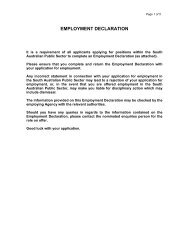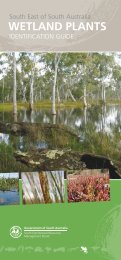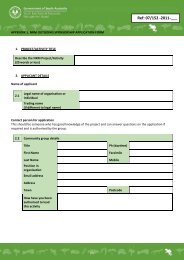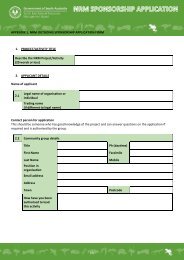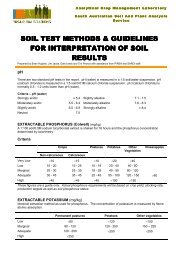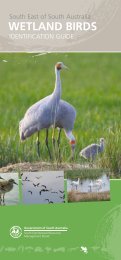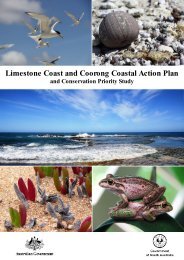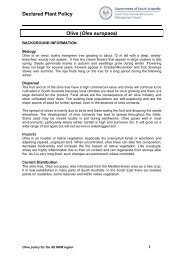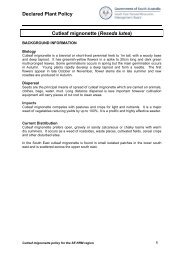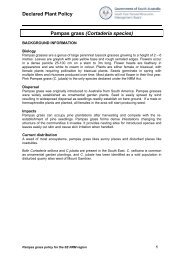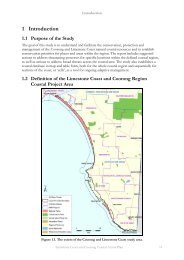Cell Descriptions - South East Natural Resources Management Board
Cell Descriptions - South East Natural Resources Management Board
Cell Descriptions - South East Natural Resources Management Board
Create successful ePaper yourself
Turn your PDF publications into a flip-book with our unique Google optimized e-Paper software.
SE11 – Guichen Bay<br />
Climate change<br />
element/ scenario<br />
decadal scale.<br />
Intensity of large<br />
storms increases.<br />
Impacts and implications<br />
(for this cell)<br />
Dawson Swamp at a 2.7 metre<br />
inundation.<br />
2070: Flooding will affect both<br />
large lakes swamps and<br />
adjacent low lying areas.<br />
Frequent storm damage to<br />
foredunes.<br />
(Impacts uncertain. Existing<br />
terrestrial vegetation is found<br />
in warmer conditions<br />
elsewhere)<br />
Protect and manage<br />
habitat threats<br />
the adaptive<br />
management of<br />
estuarine environment<br />
and lakes.<br />
Address landscape<br />
issues: fire,<br />
connectivity,<br />
refuges, hydrology<br />
Active management of<br />
dune blowouts.<br />
Warmer average<br />
conditions:<br />
2030:+0.3 to.6 0 C<br />
2070:+1.5 to 2 0 C<br />
Drier average<br />
conditions:<br />
2030: -2% to 5%<br />
2070: - 10% to 20%<br />
Maintain<br />
connectivity of<br />
vegetation within<br />
the region.<br />
Dune vegetation adapts to<br />
drier conditions, but recovers<br />
more slowly from fire and<br />
storm damage allowing weed<br />
colonisation, notably exotic<br />
grasses: dune mobilization<br />
becomes more likely.<br />
Reduced runoff and increased<br />
evaporation threatens the lakes<br />
and lakeshore habitats.<br />
Active weed control<br />
within dunes.<br />
Ensure vegetated<br />
dune areas are on<br />
region fire plan.<br />
Monitor seasonal<br />
water levels and<br />
salinity in lakes.<br />
Adaptive management<br />
of ecological assets.<br />
Maintain watching<br />
brief on sedimentation<br />
of lakes.<br />
‘Flashy’ run off:<br />
Drier creeks, but<br />
larger rare floods<br />
Drains and creeks may<br />
increase sediment load to<br />
coastal swamps and lakes (this<br />
depends on land management<br />
practices).<br />
Groundwater lowering a threat<br />
to Lakes Eliza and Robe:<br />
lowering freshwater pressure<br />
and increasing saline water<br />
pressure.<br />
Groundwater<br />
lowering; saline<br />
incursion:<br />
Monitor seasonal<br />
water levels and<br />
salinity in both lakes.<br />
Adaptive management<br />
of ecological assets.<br />
Lakes represent any<br />
obvious changes in<br />
regional<br />
groundwater levels.<br />
Lowering of<br />
regional water table<br />
(and perched water<br />
tables in dunes) a<br />
threat to all habitats.<br />
Nearshore sea<br />
changes -<br />
temperature;<br />
acidity; wave<br />
climate:<br />
2030: +0.3 0 C to +<br />
0.6 0 C<br />
Changes are unlikely to affect<br />
swell wave climate, apart from<br />
increase in mean wave period.<br />
(Changes in upwelling timing<br />
and frequency has been<br />
discussed, but not projected).<br />
2070: +1.0 0 C to +<br />
1.50C<br />
Limestone Coast and Coorong Coastal Action Plan 405



